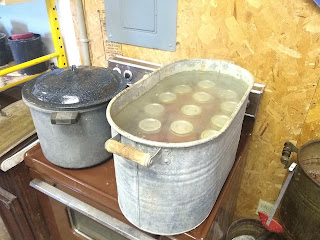The Farm Report
08 - 31 - 2022
Squirrels, Ants and Me
 |
Ain't she a beaut!? All steel and permanent - at least it will be permanent unless a tornado rips the whole thing up out of the ground and I get a chance to meet Dorothy and Toto. Barring that unhappy event, these roofs are rated to last 50 to 70 years minimum. This is a shot from an aerial drone; something you might not think an Amish crew would have. Jake says this is the most complicated roof he has done so far - and he's been doing this since he was a kid. Who says you can nod off in geometry class and not pay a price for it? Intersecting planes. See those junk piles on either side of the house. Make a mental note; I'll come back to this later. Here's a link to a photo file if you just need a huge major fix on roofing pictures. |
 |
My secret weapon: The Electric Roaster. After a wash and core - and cut out the bad spots, of course - I squeeze the maters and heap 'em up in the roaster. |
 |
This is all that is left after the electric squeezer has done it's thing. Skins and seeds. The chickens make this into eggs. Waste not/want not, they say. |
 |
Ambrosia is the variety. It is unbeatable. Delicious, big, robust. MMMMMmmmmmmmm. |
 |
Broccoli: Same drill. Gypsy is my favorite variety. It produces one big head in the spring, then these wonderful side shoots all summer long, until freeze up. |
 |
I do still steam blanch my broccoli the old fashioned way. I think it is better. This is my (Joyce's) steamer. |
 |
I like it a little more 'cooked' than blanched. Once it has that special color (about 5 minutes for me) then it gets popped into the ice water to stop the cooking music. |
 |
Shock! |
 |
"Hey Annie!" I was showing her my harvest of basil. I was excited. I thought Annie would be, too. |
 |
It has been a super busy, super hot dry and miserable summer. OJ and Annie sort of came to an agreement. |
 |
Too hot to fight, too hot to care. Neither wanted to just let the other one know that they weren't watching though. Still on duty regardless. |




















































